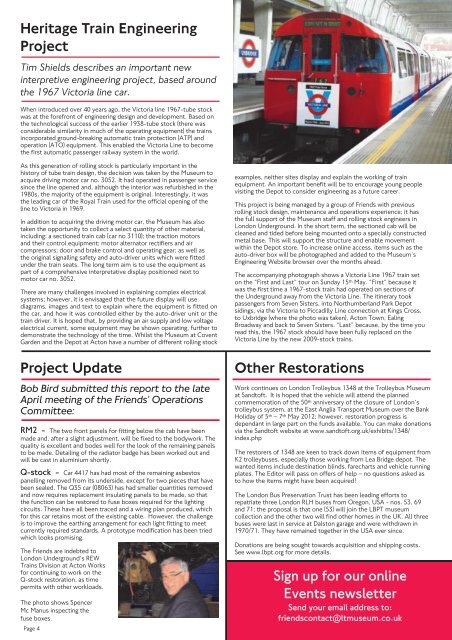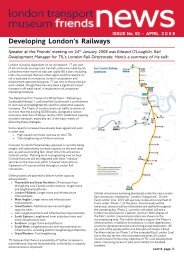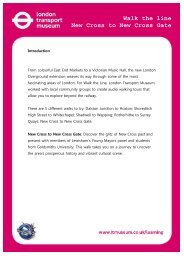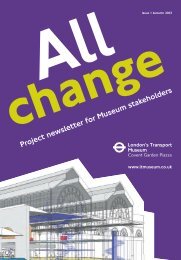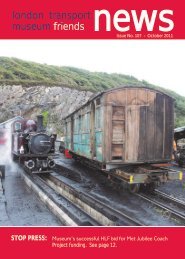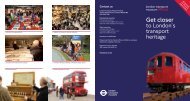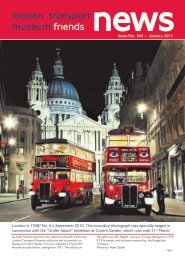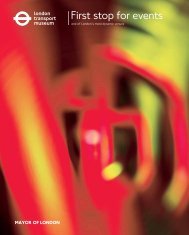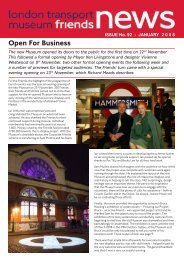london transport museum friends news
london transport museum friends news
london transport museum friends news
You also want an ePaper? Increase the reach of your titles
YUMPU automatically turns print PDFs into web optimized ePapers that Google loves.
Heritage Train Engineering<br />
Project<br />
Tim Shields describes an important new<br />
interpretive engineering project, based around<br />
the 1967 Victoria line car.<br />
When introduced over 40 years ago, the Victoria line 1967-tube stock<br />
was at the forefront of engineering design and development. Based on<br />
the technological success of the earlier 1938-tube stock (there was<br />
considerable similarity in much of the operating equipment) the trains<br />
incorporated ground-breaking automatic train protection (ATP) and<br />
operation (ATO) equipment. This enabled the Victoria Line to become<br />
the first automatic passenger railway system in the world.<br />
As this generation of rolling stock is particularly important in the<br />
history of tube train design, the decision was taken by the Museum to<br />
acquire driving motor car no. 3052. It had operated in passenger service<br />
since the line opened and, although the interior was refurbished in the<br />
1980s, the majority of the equipment is original. Interestingly, it was<br />
the leading car of the Royal Train used for the official opening of the<br />
line to Victoria in 1969.<br />
In addition to acquiring the driving motor car, the Museum has also<br />
taken the opportunity to collect a select quantity of other material,<br />
including: a sectioned train cab (car no 3110); the traction motors<br />
and their control equipment; motor alternator rectifiers and air<br />
compressors; door and brake control and operating gear; as well as<br />
the original signalling safety and auto-driver units which were fitted<br />
under the train seats. The long term aim is to use the equipment as<br />
part of a comprehensive interpretative display positioned next to<br />
motor car no. 3052.<br />
There are many challenges involved in explaining complex electrical<br />
systems; however, it is envisaged that the future display will use<br />
diagrams, images and text to explain where the equipment is fitted on<br />
the car, and how it was controlled either by the auto-driver unit or the<br />
train driver. It is hoped that, by providing an air supply and low voltage<br />
electrical current, some equipment may be shown operating, further to<br />
demonstrate the technology of the time. Whilst the Museum at Covent<br />
Garden and the Depot at Acton have a number of different rolling stock<br />
Project Update<br />
Bob Bird submitted this report to the late<br />
<br />
Committee:<br />
RM2 - The two front panels for fitting below the cab have been<br />
made and, after a slight adjustment, will be fixed to the bodywork. The<br />
quality is excellent and bodes well for the look of the remaining panels<br />
to be made. Detailing of the radiator badge has been worked out and<br />
will be cast in aluminium shortly.<br />
Q-stock - Car 4417 has had most of the remaining asbestos<br />
panelling removed from its underside, except for two pieces that have<br />
been sealed. The Q35 car (08063) has had smaller quantities removed<br />
and now requires replacement insulating panels to be made, so that<br />
the function can be restored to fuse boxes required for the lighting<br />
circuits. These have all been traced and a wiring plan produced, which<br />
for this car retains most of the existing cable. However, the challenge<br />
is to improve the earthing arrangement for each light fitting to meet<br />
currently required standards. A prototype modification has been tried<br />
which looks promising.<br />
The Friends are indebted to<br />
<br />
Trains Division at Acton Works<br />
for continuing to work on the<br />
Q-stock restoration, as time<br />
permits with other workloads.<br />
The photo shows Spencer<br />
Mc Manus inspecting the<br />
fuse boxes.<br />
Page 4<br />
examples, neither sites display and explain the working of train<br />
equipment. An important benefit will be to encourage young people<br />
visiting the Depot to consider engineering as a future career.<br />
This project is being managed by a group of Friends with previous<br />
rolling stock design, maintenance and operations experience; it has<br />
the full support of the Museum staff and rolling stock engineers in<br />
London Underground. In the short term, the sectioned cab will be<br />
cleaned and tided before being mounted onto a specially constructed<br />
metal base. This will support the structure and enable movement<br />
within the Depot store. To increase online access, items such as the<br />
auto-<br />
Engineering Website browser over the months ahead.<br />
The accompanying photograph shows a Victoria Line 1967 train set<br />
th <br />
was the first time a 1967-stock train had operated on sections of<br />
the Underground away from the Victoria Line. The itinerary took<br />
passengers from Seven Sisters, into Northumberland Park Depot<br />
sidings, via the Victoria to Piccadilly Line connection at Kings Cross,<br />
to Uxbridge (where the photo was taken), Acton Town, Ealing<br />
<br />
read this, the 1967 stock should have been fully replaced on the<br />
Victoria Line by the new 2009-stock trains.<br />
Other Restorations<br />
Work continues on London Trolleybus 1348 at the Trolleybus Museum<br />
at Sandtoft. It is hoped that the vehicle will attend the planned<br />
commemoration of the 50 th <br />
trolleybus system, at the East Anglia Transport Museum over the Bank<br />
Holiday of 5 th 7 th May 2012; however, restoration progress is<br />
dependant in large part on the funds available. You can make donations<br />
via the Sandtoft website at www.sandtoft.org.uk/exhibits/1348/<br />
index.php<br />
The restorers of 1348 are keen to track down items of equipment from<br />
K2 trolleybuses, especially those working from Lea Bridge depot. The<br />
wanted items include destination blinds, farecharts and vehicle running<br />
plates. The Editor will pass on offers of help no questions asked as<br />
to how the items might have been acquired!<br />
The London Bus Preservation Trust has been leading efforts to<br />
repatriate three London RLH buses from Oregon, USA - nos. 53, 69<br />
and 71; the proposal is that one (53) will join the LBPT <strong>museum</strong><br />
collection and the other two will find other homes in the UK. All three<br />
buses were last in service at Dalston garage and were withdrawn in<br />
1970/71. They have remained together in the USA ever since.<br />
Donations are being sought towards acquisition and shipping costs.<br />
See www.lbpt.org for more details.<br />
Sign up for our online<br />
Events <strong>news</strong>letter<br />
Send your email address to:<br />
<strong>friends</strong>contact@lt<strong>museum</strong>.co.uk


